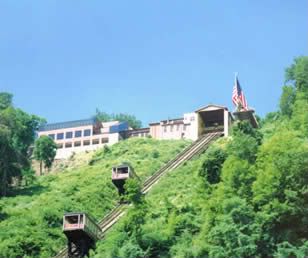
Johnstown Inclined Plane
(photo from the Johnstown Area Heritage Association)
Built in 1891, the Johnstown Inclined Plane was constructed as a "lifesaver" after the Johnstown Flood of 1889, meant to carry people from the river valley to the safety of the heights above in an emergency while getting workers to and from the Cambria Iron Works and Rolling Hills mine.
It served its purpose well during the 1936 Flood when it carried 4,000 men, women and children to safety atop Yoder Hill when flood waters again submerged the City.
In over 80 years of operation the Inclined Plane Railway has carried over 40 million passengers and countless vehicles. The Guinness Book of Records rates it as "The steepest vehicular inclined plane in the world."
One of its highlights is the James Wolfe Sculpture Trail. This popular hiking trail winds past the Incline and along the Stony Brook River.
The 1-1/2 mile long trail climbs 500' along the hillside between the top and bottom of the Plane. Spaced along the way are eight steel sculptures created by sculptor James Wolfe.
On July 10, 1902, 112 miners lost their lives in an explosion in the Cambria Iron Company's nearby Rolling Mills mine. People have claimed to see apparitions of phantom miners walking the James Wolfe Sculpture trail that leads up to the mine entrance.
There have been sightings of a lone miner on the trail who disappears as you approach him, and of a pair of miners holding their lunch buckets at the base of the Johnstown Inclined Plane, still waiting for their ride. The spook of a young boy has been reportedly seen there, too.
The sightings date back even further. It's alleged that there was an Indian burial ground near the top of the Plane, and floating lights have been seen dancing around the Native American's final resting place.
So if you get to visit J-Town and ride the Plane to its impressive observation deck, keep your eyes peeled. You may see more below you than the Stony Brook river valley.

No comments:
Post a Comment